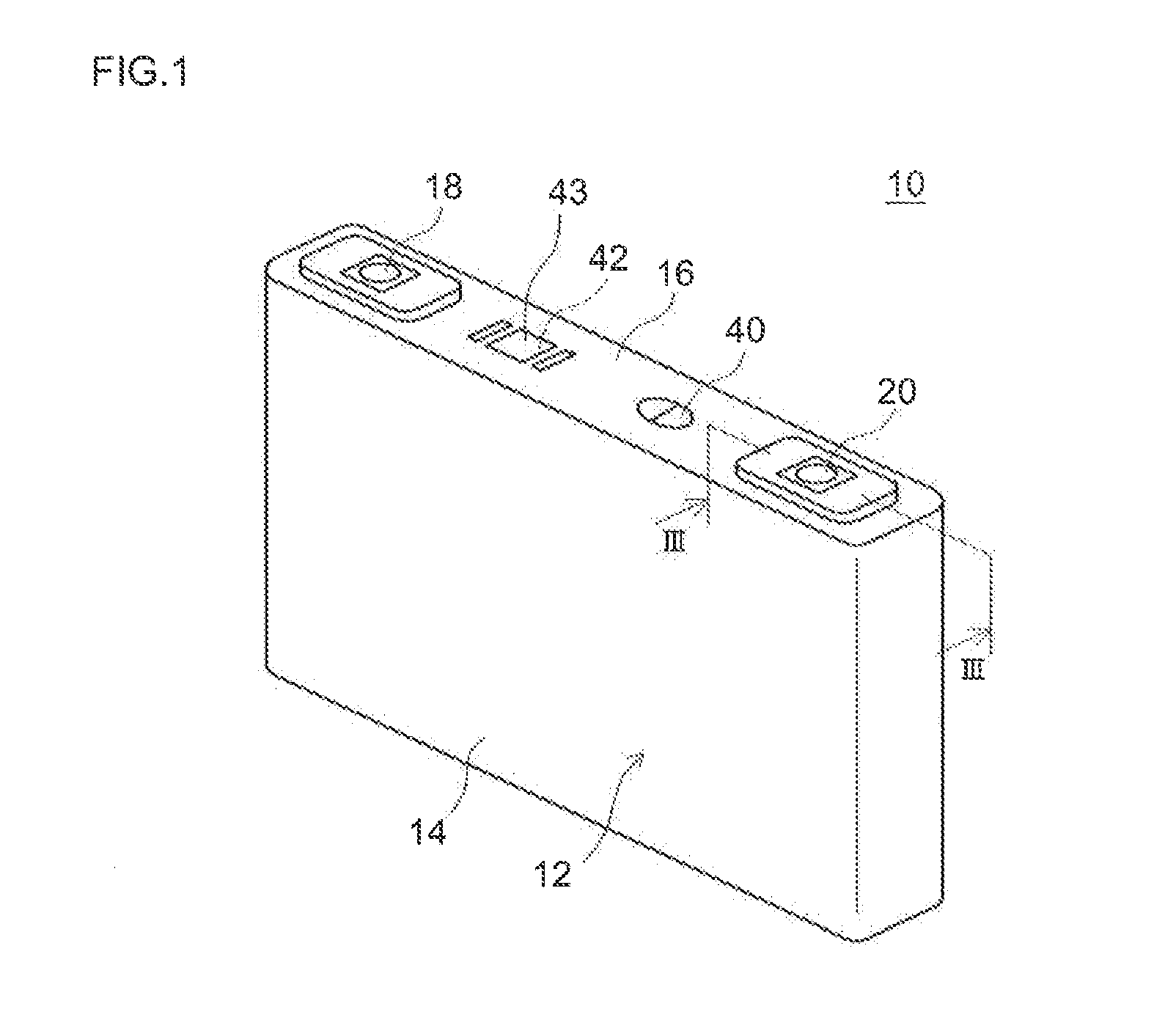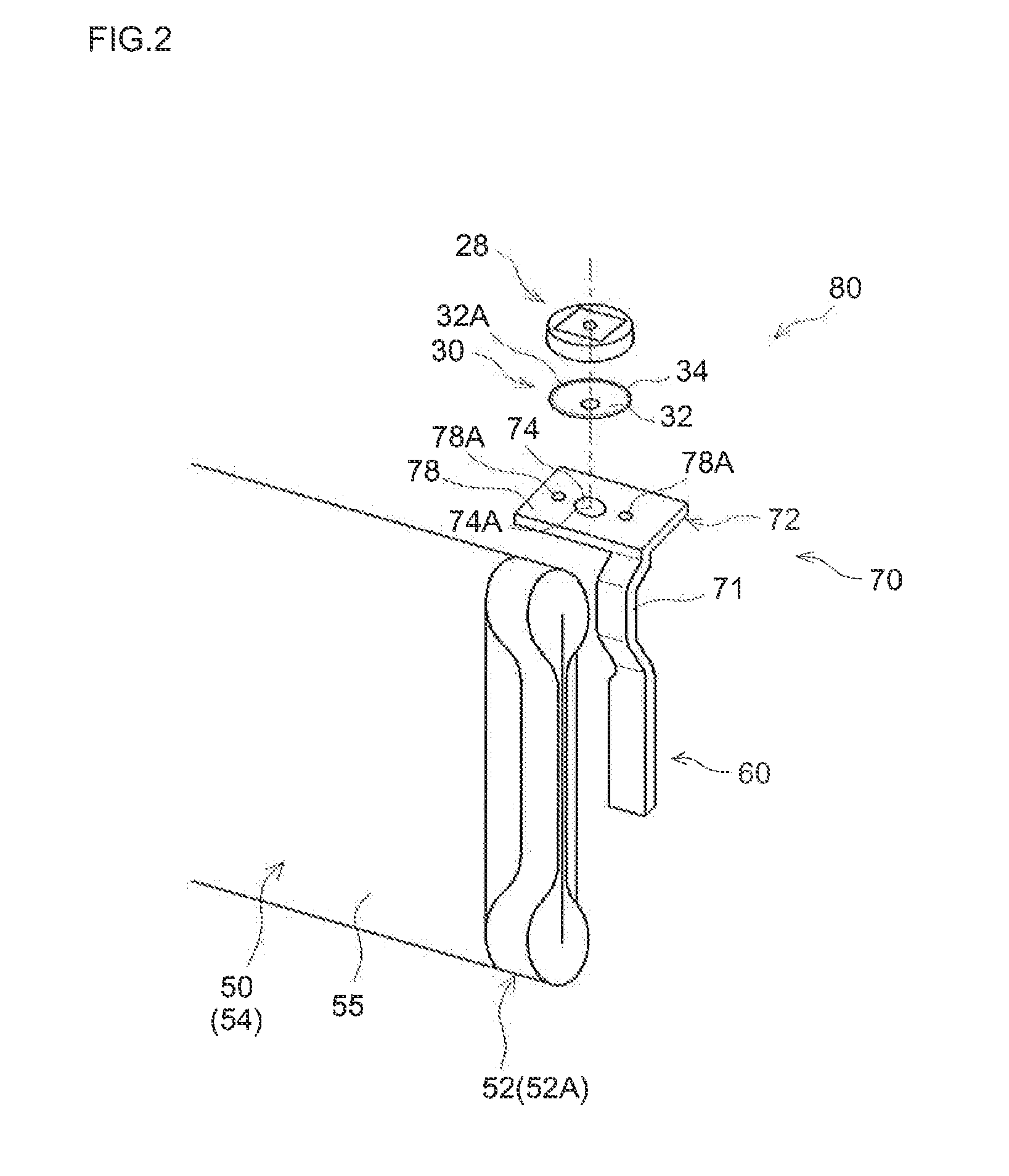Sealed secondary battery
a secondary battery and seal technology, applied in the direction of batteries, cell components, cell component details, etc., can solve problems such as deformation of the case, and achieve the effect of quick disconnecting the conduction path
- Summary
- Abstract
- Description
- Claims
- Application Information
AI Technical Summary
Benefits of technology
Problems solved by technology
Method used
Image
Examples
first embodiment
[0048]FIG. 1 shows a simplified perspective view illustrating the outer shape of a lithium-ion secondary battery according to the first embodiment. FIG. 2 shows an exploded perspective view illustrating the configuration of its current-blocking system. FIG. 3 shows a schematic cross-sectional view showing a close-up of the current-blocking system in cross section along III-III in FIG. 1.
[0049](Overall Constitution of Battery)
[0050]Lithium-ion secondary battery 10 according to the present embodiment is configured such that a flat wound electrode unit 50 as shown in FIG. 2 is housed in a battery case (i.e. exterior container) 12 shown in FIG. 1, along with a liquid electrolyte (electrolyte solution) not shown in the drawing.
[0051]Battery case 12 has a flat square shape corresponding to the shape of wound electrode unit 50. It is constituted with a box-shape (i.e. bottomed cuboid) main casing 14 having an opening at one end (corresponding to the top end of battery 10 in normal usage) a...
first example
of Modification
[0077]With reference to FIG. 16, here is described a modification example of lithium-ion secondary battery 10 according to the first embodiment (a lithium-ion secondary battery configured such that an annular groove 79 is provided to a thin portion 74 wherein a pressure-sensitive deformable portion 32 is securely joined to the thin portion of current collector at the inner side of the groove 79, and by snap-through deformation of the pressure-sensitive deformable portion, the thin portion 74 is caused to break off at the groove 79 while retaining the joint). In the example shown in FIG. 16, the thin portion 74 and groove 79 in current collector plate 72 in the first embodiment shown in FIG. 3 are omitted, and a current collector plate 72 having a uniform thickness is illustrated as shown in FIG. 16. By joining (e.g. welding) a pressure-sensitive deformable portion 32 to the central portion of the current collector plate 72, pressure-sensitive member (first conductive ...
second example
of Modification
[0080]As another example of modification of lithium-ion secondary battery 10 according to the first embodiment, instead of joining pressure-sensitive member 30 and current collector 70 together, it can be configured as shown in FIG. 17, such that pressure-sensitive deformable portion 32 of pressure-sensitive member (first conductive member) 30 directly contacts current collector (second conductive member) 70 (preferably, pressure-sensitive member 30 is elastically pushed against current collector 70) so as to attain conduction upon direct connection between pressure-sensitive member 30 and current collector 70 while pressure-sensitive deformable portion 32 is in the first state. In the example shown in FIG. 17, with the flat portion 32C of pressure-sensitive deformable portion 32 being elastically pushed against the top face of the central portion of current collector plate 72 in the first modification example, conduction between the two members is maintained. In the ...
PUM
| Property | Measurement | Unit |
|---|---|---|
| thickness | aaaaa | aaaaa |
| height | aaaaa | aaaaa |
| height | aaaaa | aaaaa |
Abstract
Description
Claims
Application Information
 Login to View More
Login to View More - R&D
- Intellectual Property
- Life Sciences
- Materials
- Tech Scout
- Unparalleled Data Quality
- Higher Quality Content
- 60% Fewer Hallucinations
Browse by: Latest US Patents, China's latest patents, Technical Efficacy Thesaurus, Application Domain, Technology Topic, Popular Technical Reports.
© 2025 PatSnap. All rights reserved.Legal|Privacy policy|Modern Slavery Act Transparency Statement|Sitemap|About US| Contact US: help@patsnap.com



